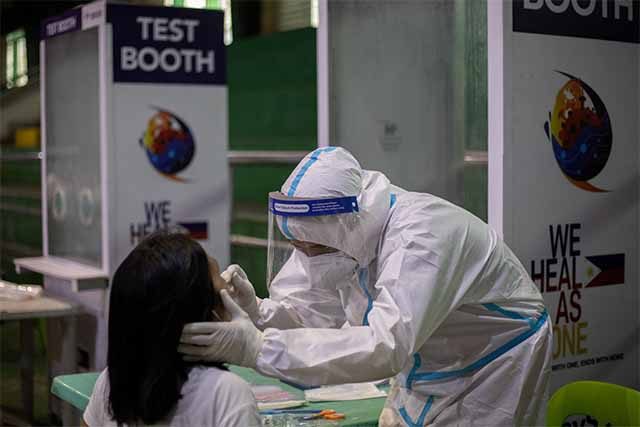
Months after rejecting calls for mass testing, the government admitted that nearly 8,000 COVID-19 test kits that could have been used to diagnose more than 300,000 cases have expired.
The Department of Health at a Senate Blue Ribbon Committee hearing into the COVID-19 pandemic response funds said that 7,925 reverse transcription-polymerase chain reaction (RT-PCR) test kits with a six-month shelf life have expired.
Health Assistant Secretary Nestor Santiago said that depending on their brand, a test kit can conduct 40 to 50 swab tests. He claimed that his record shows that nearly 8,000 tests kits are capable of conducting 371,794 swab tests.
Opposition Sen. Kiko Pangilinan estimated that these were all worth about P550 million, based on the P69,500 price per pack of 30 to 50 test kits sold by the Pharmally Pharmaceutical Corp. to the Procurement Service of the Department of Budget and Management (PS-DMB).
“When it is expiring in six months, you have as much as 25% discount,” he was quoted as saying, citing industry insiders as his source.
“Yet the full amount was paid,” Pangilinan added.
“And in the middle of a situation where we were not testing enough… para tayong nagsusunog ng pera sa gitna ng napakaraming namamatay,” he further said.
Health Secretary Francisco Duque III said it was only 3.6% of the total cost of testing so far.
He added that the test kits with a six-month lifespan were the only ones available at that time.
“These test kits were only developed in 2020, there was no data [to indicate] that these could be stored and used longer beyond six months,” Duque was quoted in the hearing.
Sen. Richard Gordon, chairman of the Philippine Red Cross, said that the humanitarian organization bought test kits from Sansure worth only P750 per test.
“Walang pumito, bakit pinipili ni Secretary Lao na Pharmally na ahente lamang na nagpapatong, at hindi natin alam kung sino nag-supply,” he said, referring to former PS-DBM head Lloyd Christopher Lao.
‘Mass testing na sana’
The revelation about the expired COVID-19 test kits didn’t amuse Filipinos who recalled the public clamor for the government’s conduct of mass testing.
“Tapos tinitipid mga tao sa testing? ‘Yung iba hindi pinapa-test kasi wala naman symptoms?” a Twitter user said in response to the reports.
“We lack money, we lack testing, we have been hitting record highs and now these expired testing kits. Obviously incompetence. More than that, this is criminal,” another online user wrote.
“When people were shouting for mass testing (at) the beginning of pandemic and had to pay thousands, and yet here we are with the expired kits,” a different Twitter user said.
“Sayang ang expired na test kits! Kung alam namang sobra, nag-mass testing na sana. ANG MAHAL MAGPA-TEST! Madami akong nakita sa news na hindi pinapasok sa hospital kasi walang COVID 19 test result tapos ‘yung iba namatay pa. Another palpak moment under Duque’s watch,” another Filipino claimed.
Earlier this year, testing czar Vince Dizon dismissed calls for mass testing as it supposedly refers to testing the entire population of the Philipines at 110 million.
He said that the government’s approach is called risk-based and targeted testing.
“Hindi pupuwede na ang tao mismo ang magdi-determine kung siya ay dapat magpa-test o hindi dahil kailangan ito ay either irirekomenda ng isang doktor, kung ikaw ay may sintomas or papasok ka sa guidelines na sinet ng eksperto,” Dizon said last April.
He added that the guidelines indicate that symptomatic patients, their contacts and those in high-risk areas are the ones that needed testing.
Dizon also said that testing alone will not stop the spread of COVID-19 and that minimum public health protocols should be strictly practiced to prevent the virus’ transmission.
Earlier this month, he admitted that the country’s testing efforts needed improvement but reiterated that there are guidelines about the initiative.
“We have to understand that we always follow the advice of our experts that we cannot just test shotgun, meaning magte-test tayo ng walang basis,” Dizon said in an interview this month.
“It needs to be risk-based and it needs to be based on the guidelines that have been approved by the experts and the Department of Health,” he added.
Medical journal BMJ said that mass testing for COVID-19 aims “to find people with active infection who are asymptomatic or presymptomatic so that quarantine, and rapid finding and testing of close contacts, can interrupt spread.” It added:
“To be effective, testing needs to be accessible even to the most disadvantaged people in society, and those tested need to receive support, information, and advice from experienced practitioners. Otherwise, the system will be chaotic, wasteful, ineffective, and harmful.”
Dr. Tony Leachon, a former pandemic response task force special adviser, previously said that the country’s testing is very low since it has a high positivity rate.
As of Monday, the Philippines has a positivity rate of 24.9%.
The World Health Organization, the positivity rate should be below 5% to show that the infection has been controlled.
“If you don’t test enough, you will not decrease the positivity rate and you will continue to transmit the infection,” Leachon said in an interview before.
WHO has repeatedly stressed since last year that mass testing remains one of the best ways to slow the advance of the pandemic.
“All countries should be able to test all suspected cases, they cannot fight this pandemic blindfolded,” WHO Director General Tedros Adhanom Ghebreyesus said before.
The WHO chief said cases cannot be isolated without testing and that the chain of infection in a community will not be broken if there is no detection.









